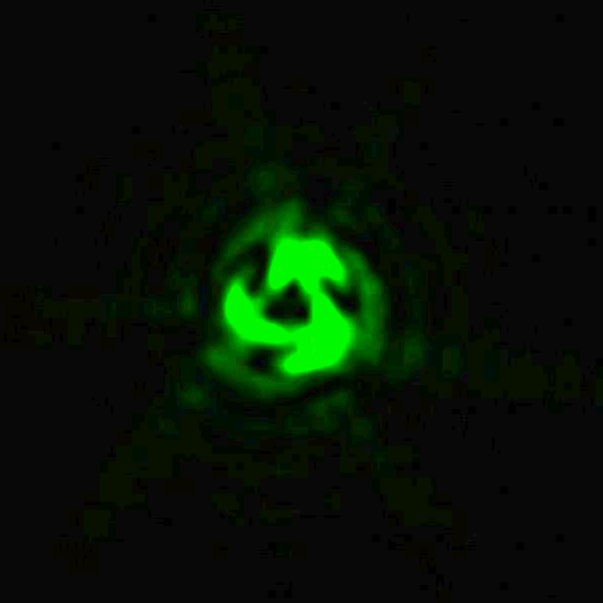Nov 3 2017
There is no new thing under the sun — except perhaps light itself.
Over the last ten years, Applied Physicists have created nanostructured materials that can form totally new states of light displaying peculiar behavior, such as corkscrewing, bending in a spiral, and dividing like a fork.
 A metasurface uses circularly polarized light to generate and control new and complex states of light, such swirling vortices of light. The new tool can be used to not only explore new states of light but also new applications for structured light. (Image courtesy of Second Bay Studio/Harvard SEAS)
A metasurface uses circularly polarized light to generate and control new and complex states of light, such swirling vortices of light. The new tool can be used to not only explore new states of light but also new applications for structured light. (Image courtesy of Second Bay Studio/Harvard SEAS)
These self-styled structured beams not only can tell Researchers much about the physics of light, they have an extensive range of applications from super resolution imaging to molecular manipulation and communications.
Currently, Researchers at the Harvard John A. Paulson School of Engineering and Applied Sciences have built a tool to make new, more complex states of light in a totally different way.
The research details can be found in Science.
We have developed a metasurface which is a new tool to study novel aspects of light. This optical component makes possible much more complex operations and allows researchers to not only explore new states of light but also new applications for structured light.
Federico Capasso, the Robert L. Wallace Professor of Applied Physics and Vinton Hayes Senior Research Fellow, Electrical Engineering, SEAS and Senior Author of the Paper
The Harvard Office of Technology Development has protected the intellectual property connected to this project and is looking at commercialization opportunities.
The new metasurface links two aspects of light, known as orbital angular momentum and circular polarization (or spin angular momentum). Polarization is course along which light vibrates. In circularly polarized light, the light vibration traces a circle. Imagine orbital angular momentum and circular polarization to be like the motion of a planet. Circular polarization is the course in which a planet rotates on its axis while orbital momentum defines how the planet orbits the sun.
The fact that light can even transport orbital momentum is a relatively new discovery — only around 25 years old — but it is this property of light which creates peculiar new states, such as beams in the shape of corkscrews.
Earlier research has applied the polarization of light to regulate the shape and size of these unique beams but the connection was restricted because only specific polarizations could convert to specific orbital momentums.
This research, however, considerably expands that connection.
This metasurface gives the most general connection, through a single device, between the orbital momentum and polarization of light that’s been achieved so far.
Robert Devlin, Co-First Author of the Paper and Former Graduate Student, The Capasso Lab
The device can be engineered so that any input polarization of light can bring about orbital angular momentum output — meaning any polarization can produce any kind of structured light, from corkscrews and spirals to vortices of any size. Besides, the multifunctional device can be automated so that one polarization results in one vortex and a different polarization occurs in a totally different vortex.
“This is a completely new optical component,” said Antonio Ambrosio, Principal Scientist at Harvard Center for Nanoscale Systems (CNS) and Co-first Author of the paper. “Some metasurfaces are iterations or more efficient, more compact versions of existing optical devices but, this arbitrary spin-to-orbital conversion cannot be done with any other optical device. There is nothing in nature as well that can do this and produce these states of light.”
One probable application is in the domain of molecular manipulation and optical tweezers, which use light to transfer molecules. The orbital momentum of light is sufficiently strong to make microscopic particles rotate and move.
“You can imagine, if we illuminate the device with one polarization of light, it will create a force of a particular kind,” said Ambrosio. “Then, if you want to change the force, all you need to do is change the polarization of the incoming light. The force is directly related to the design of the device.”
High-powered imaging is another application. The black hole in the center of the vortex, referred to as the zero-light intensity region, can image features smaller than the diffraction limit, which is typically half of the wavelength of light. By altering the polarization of light, the size of this core region can be transformed to focus different-sized features.
But these beams can also offer insight on vital questions of physics.
These particular beams are first and foremost of fundamental scientific interest. There is interest in these beams in quantum optics and quantum information. On the more applied side, these beams could find application in free-space optical communication, especially in scattering environments where this is usually difficult. Moreover, it has been recently shown that similar elements can be incorporated into lasers, directly producing these novel states of light. This may lead to unforeseen applications.
Noah Rubin, Co-first Author of the paper and Graduate Student, The Capasso Lab
The paper was co-authored by J.P. Balthasar Mueller and supported partly by the Air Force Office of Scientific Research.

A metasurface can generate strange new beams of light that swirl and corkscrew. The black hole in the center of these vortices can be used to image features smaller than half a wavelength of light or move tiny molecules. (Video courtesy of the Capasso Lab/Harvard SEAS)